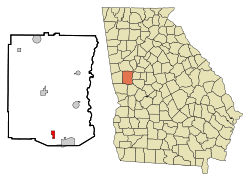Warm Springs, Georgia
Warm Springs, Georgia | |
|---|---|
 Location in Meriwether County and the state of Georgia | |
| Country | United States |
| State | Georgia |
| County | Meriwether |
| Area | |
| • Total | 1.2 sq mi (3.1 km2) |
| • Land | 1.2 sq mi (3.1 km2) |
| • Water | 0 sq mi (0 km2) |
| Elevation | 930 ft (280 m) |
| Population (2010) | |
| • Total | 478 |
| • Density | 398.3/sq mi (153.8/km2) |
| Time zone | UTC-5 (Eastern (EST)) |
| • Summer (DST) | UTC-4 (EDT) |
| ZIP code | 31830 |
| Area code | 706 |
| FIPS code | 13-80480Template:GR |
| GNIS feature ID | 0324851Template:GR |


Warm Springs is a city in Meriwether County, Georgia, United States. The population was 478 at the 2010 census.
History
Warm Springs first came to prominence in the 19th century as a spa town, due to its mineral springs which flow constantly at nearly 32 °C (90 °F). It is famous for the Little White House, where Franklin D. Roosevelt lived while president, because of his paralytic illness. He died there in 1945 and it is now a public museum. Roosevelt first came in the 1920s in hopes that the warm water would improve his paraplegia, at the time thought to be due to polio. He was a constant visitor for two decades. The town is still home to the Roosevelt Warm Springs Institute for Rehabilitation (Roosevelt's former polio hospital) which remains a world-renowned comprehensive rehabilitation center including a physical rehabilitation hospital and vocational rehabilitation unit. The springs are not available for public use as a bath/spa resort, but they are used by the Roosevelt Institute for therapeutic purposes.
Geography
Warm Springs is located at 32°53′19″N 84°40′48″W / 32.88861°N 84.68000°W (32.888689, -84.680089)Template:GR.
According to the United States Census Bureau, the city has a total area of 1.2 square miles (3.1 km2), of which, 1.2 square miles (3.1 km2) of it is land and 0.83% is water.
Demographics
As of the censusTemplate:GR of 2010, there were 485 people, 172 households, and 107 families residing in the city. The population density was 409.7 people per square mile (158.7/km²). There were 208 housing units at an average density of 175.7 per square mile (68.1/km²). The racial makeup of the city was 67.22% White, 31.75% African American, and 1.03% from two or more races.
There were 172 households out of which 26.9% had children under the age of 18 living with them, 34.3% were married couples living together, 25.1% had a female householder with no husband present, and 36.6% were non-families. 34.3% of all households were made up of individuals and 16.0% had someone living alone who was 65 years of age or older. The average household size was 2.33 and the average family size was 2.99.
In the city the population was spread out with 21.2% under the age of 18, 7.4% from 18 to 24, 22.1% from 25 to 44, 20.6% from 45 to 64, and 28.7% who were 65 years of age or older. The median age was 45 years. For every 100 females there were 62.8 males. For every 100 females age 18 and over, there were 57.2 males.
The median income for a household in the city was $21,547, and the median income for a family was $29,950. Males had a median income of $24,422 versus $13,110 for females. The per capita income for the city was $14,872. About 14.7% of families and 16.4% of the population were below the poverty line, including 21.7% of those under age 18 and 9.3% of those age 65 or over.
Notable residents
- US President Franklin Delano Roosevelt lived in the Little White House in Warm Springs while he was not in Washington.
- After graduating from John H. Francis Polytechnic High School, Cosomopolitan Magazine Editor Helen Gurley Brown and her family moved to Warm Springs.[1]
yellow fever:lived and died here
References
- ^ Scanlon, Jennifer (2009). Toff, Nancy (ed.). Bad Girls Go Everywhere: The Life of Helen Gurley Brown. Oxford University Press. p. 17. ISBN 978-0-19-534205-5.

